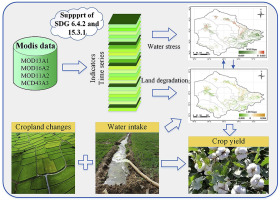Journal of Cleaner Production ( IF 11.1 ) Pub Date : 2020-01-11 , DOI: 10.1016/j.jclepro.2020.120114 Liangliang Jiang , Guli·Jiapaer , Anming Bao , Ye Yuan , Guoxiong Zheng , Hao Guo , Tao Yu , Philippe De Maeyer

|
Water scarcity constitutes an important challenge faced by croplands in the Aral Sea basin (ASB). The croplands in the ASB are highly vulnerable to water stress and land degradation and experience high anthropogenic disturbances. This study investigated the spatiotemporal patterns of water stress and land degradation and detected the years with abrupt changes in the water stress index (WSI) by applying linear regression analysis and the breaks for additive seasonal and trend (BFAST) method. Furthermore, these analyses were combined with statistical data on water intake to explore the relationship between water stress and land degradation in the sub-basins. The results revealed that water stress was more serious in the downstream areas than in the upstream area. The downstream regions experienced increasing water stress, resulting in severe land degradation and cropland abandonment. The BFAST results indicated that abrupt changes in the WSI mainly occurred in 2005, 2008 and 2010. The correlations between water intake, water stress and land degradation in the lower reach were stronger than those in the upper reach. Subsequently, the water intake had a great influence on the cropping intensity and cotton yield in the downstream regions. Water stress in different regions was caused by different drivers. In the upstream areas, precipitation was the major driver of water stress in crops. In contrast, the water allocation in the middle and lower reaches was affected by anthropogenic disturbances and resulted in serious water deficits in the Amudarya River delta in 2000 and 2008. Because each country had a unique irrigation scheme and cropping pattern, obvious spatial differences in water stress and land degradation changes were detected between Tashauz and Karakalpakstan. This study can provide a decision-making reference for the implementation of sustainable development goals in the ASB.
中文翻译:

水分胁迫对咸海盆地农田的影响
缺水是咸海盆地(ASB)农田面临的重要挑战。ASB的耕地极易遭受水分胁迫和土地退化,并遭受高度的人为干扰。这项研究调查了水分胁迫和土地退化的时空格局,并通过应用线性回归分析和加性季节性和趋势折断法(BFAST)来检测水分胁迫指数(WSI)突变的年份。此外,这些分析与取水统计数据相结合,以探讨子流域水分胁迫与土地退化之间的关系。结果表明,下游地区的水分胁迫比上游地区更为严重。下游地区的水压力增加,导致严重的土地退化和耕地被遗弃。BFAST结果表明,WSI的突然变化主要发生在2005年,2008年和2010年。下游的取水量,水分胁迫和土地退化之间的相关性强于上游的。随后,取水量对下游地区的种植强度和棉花产量影响很大。不同地区的水分胁迫是由不同的驱动因素引起的。在上游地区,降水是造成作物缺水的主要原因。相比之下,中下游的水分配受到人为干扰的影响,并导致2000和2008年阿蒙达拉河三角洲的严重缺水。由于每个国家都有独特的灌溉计划和种植方式,Tashauz和Karakalpakstan之间的水分胁迫和土地退化变化存在明显的空间差异。这项研究可以为在ASB中实施可持续发展目标提供决策参考。


























 京公网安备 11010802027423号
京公网安备 11010802027423号